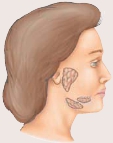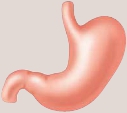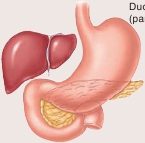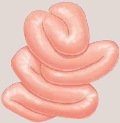CHAPTER 24 Digestive System
911
Carbohydrates
Mouth(salivary glands)
Lipids
Proteins

Salivary amylase
Linguallipase
Polysaccharides, disaccharides
Stomach

Gastriclipase
Pepsin
Polypeptides
Duodenum(pancreas, liver)
Bile salts(liver)
Pancreatic amylase
Pancreaticlipase
Trypsin, chymotrypsin,carboxypeptidase(pancreas)

Disaccharides
Epithelium ofsmall intestine
Peptides

Disaccharidases
Peptidases
Monosaccharides
Fatty acids,monoglycerides
Amino acids,dipeptides,tripeptides
FIGURE 24.28
Digestion of the Three Major Food Types
The enzymes involved in digesting carbohydrates, lipids, and proteins are depicted in relation to the region of the digestive tract whereeach functions.
About 15% of the cholesterol in the body is ingested in thefood we eat. Eating foods containing saturated fatty acids canraise plasma cholesterol levels by stimulating LDL productionand inhibiting LDL receptor production. Conversely, ingestingunsaturated fatty acids lowers plasma cholesterol. Replacingfats with carbohydrates in the diet can also reduce blood choles-terol. The remaining 85% is manufactured in body cells, mostlyin the liver and intestinal mucosa. Most of the cholesterol andother lipids taken into or manufactured in the liver leave theliver in the form of VLDL. Most of the triglycerides areremoved from the VLDL to be stored in adipose tissue; as aresult, VLDL becomes LDL.
The cholesterol in LDL is critical for the production of steroidhormones and bile salts in the liver. It is also an important compo-nent of plasma membranes. Abnormally low cholesterol levelsmay lead to weakened blood vessel walls and an increased risk forcerebral hemorrhage.LDL is delivered to cells of various tissues through the blood.Cells have
LDL receptors
in “pits” on their surfaces, which bindthe LDL. Once LDL is bound to the receptors, the pits on the cellsurface become endocytotic vesicles, and the cell takes in LDL byreceptor-mediated endocytosis (figure 24.32). For example, eachfibroblast has 20,000–50,000 LDL receptors on the surface. How-ever, those receptors are confined to cell surface pits, which